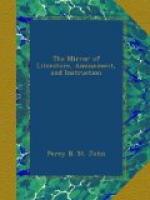The space occupied by the ancient city is stated to have been nearly 2,000 feet in diameter, surrounded with a fosse, or ditch, of immense depth, and two ramparts, inner and outer: on the inner, which was much higher than the outer, stood a wall nearly 12 feet thick at its foundation, of flint and chalk, strongly cemented together, and cased with hewn stone, on which was a parapet with battlements. In the centre, on the summit of the hill, stood the castle or citadel, surrounded with a very deep intrenchment and a high rampart; and in the area beneath, forming a wide space between the inner and outer ramparts, stood the city, divided into equal parts, north and south; near the middle of each division was a gate—these two being the grand entrances, with a tower and mole over and before each. Besides these were ten other towers, at equal distances round the city; and opposite them, in a straight line with the castle, were built the principal streets, intersected in the middle with one grand circular street, encompassing the whole city. In the angle to the north-west stood the cathedral, and episcopal palace, and the houses of the clergy.
The area of the city was also divided into nearly equal parts by intrenchments and ramparts thrown up, by which means if one part was taken, the other was still defensible; and if the whole of the out-works were in the hands of the enemy, the besieged could retire to the castle, whose walls were impregnable. There appears to have been but one entrance to the castle, on the east. There were five wells, four in the city and one in the castle, designed chiefly to support the garrison and inhabitants in time of war, or during a siege.
The decline of Sarum, which was very rapid, has been traced to a disagreement between the civil and ecclesiastical authorities. During the reign of Henry I. the bishop of Old Sarum, who rose to that dignity, from being a parish priest at Caen, was entrusted with the keys of the fortress. The bishop, however, fell into disgrace, the king resumed the command of the castle, and the military openly insulted the disgraced prelate and the clergy. These animosities increasing, the Empress Maude bestowed many gifts upon the cathedral, and added much land to its grants. Herbert, a subsequent bishop of the see, attempted to remove the establishment, but its execution was reserved for his brother and successor, Richard Poor, whose monument is in the south chancel of the present cathedral at Salisbury. This was about the year 1217, from which time the inhabitants of Old Sarum removed their residence, and pulled down their dwellings, with the materials of which they constructed their new habitations: and as one city increased in population and extent, so the other almost as rapidly decayed. Hence the establishment of New Sarum, or Salisbury.
In the reign of Edward II. Sarum possessed the privilege of sending two members to parliament, a privilege which it still retains.




